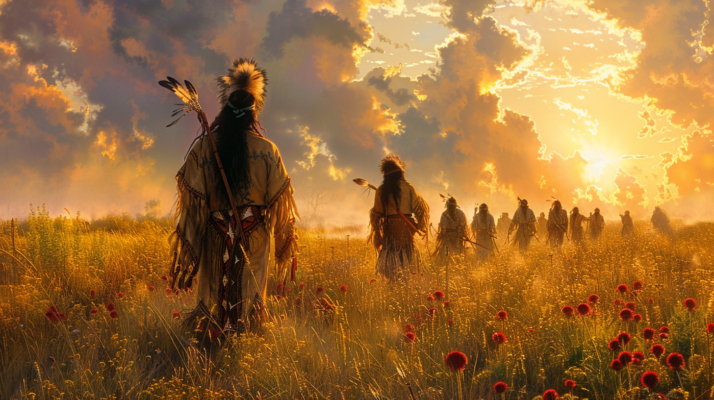Discover seven key facts about this tragic period in American history.
Davy Crockett Opposed Indian Removal
Frontiersman Davy Crockett, whose grandparents were killed by Muscogees and Cherokees, was a scout for Andrew Jackson during the Creek War (1813-14). However, while serving as a U.S. congressman from Tennessee, Crockett broke with President Jackson over the Indian Removal Act, calling it unjust. Despite warnings that his opposition would cost him his seat in Congress, where he’d served since 1827, Crockett declared, ‘I would sooner be honestly and politically damned than hypocritically immortalized.’
The year after the act’s passage in 1830, Crockett lost his bid for reelection. After being voted back into office in 1833, he continued to express his opposition to Jackson’s policy and wrote that he would leave the U.S. for the ‘wilds of Texas’ if Martin Van Buren, Jackson’s vice president, succeeded him in the White House. After Crockett was again defeated for reelection in 1835, he did go to Texas, where he died fighting at the Alamo in March 1836.
Renegade Cherokees Signed a Treaty Selling All Tribal Lands
John Ross, of Scottish and Cherokee ancestry and the tribe’s principal chief since 1828, strongly opposed relinquishing the Cherokees’ ancestral lands, as did the majority of the Cherokee people. However, a small group within the tribe believed it was inevitable that white settlers would keep encroaching on their lands, and therefore the only way to preserve Cherokee culture and survive as a tribe was to move west. In 1835, while Ross was away, this minority faction signed a treaty at New Echota, the Cherokee Nation capital (in Georgia), agreeing to sell all tribal lands in the East to the U.S. government in exchange for $5 million and new land in the West. The government was also supposed to cover the Cherokees’ moving costs and support them during their first year in Indian Territory.
When Ross learned about the treaty, he argued it had been made illegally. Nevertheless, in 1836, it was ratified by the margin of a single vote in the U.S. Senate and signed by President Jackson. The treaty gave the Cherokees two years to vacate their lands. In June 1839, after the Cherokees had been forced to relocate to Indian Territory, several leaders of the so-called Treaty Party who had advocated for the New Echota agreement were assassinated by tribe members who had opposed removal to the west.
Martin Van Buren Ordered the Roundup of the Cherokees
During his presidency (1829-1837), Andrew Jackson implemented the Indian removal policy but left office before the 1838 deadline for the Cherokees to surrender their lands. His successor, Martin Van Buren, ordered General Winfield Scott to forcibly evict the Cherokees. Scott’s troops rounded up about 16,000 Cherokees, imprisoning them in forts across Georgia, Tennessee, North Carolina, and Alabama without time to pack. Families were often separated, and they were transferred to detention camps, mostly in Tennessee, where living conditions were bleak and diseases rampant, resulting in many deaths.
The Trail of Tears Wasn’t Just One Route
The first group of Cherokees departed Tennessee in June 1838 and headed to Indian Territory by boat, a journey that took them along the Tennessee, Ohio, Mississippi, and Arkansas rivers. Heat and extended drought soon made travel along this water route impractical, so that fall and winter, thousands more Cherokees were forced to trek from Tennessee to present-day Oklahoma via one of several overland routes. Federal officials allowed Chief John Ross to take charge of these overland removals, and he organized the Native Americans into 13 groups, each comprised of nearly a thousand people. Although there were some wagons and horses, most people had to walk.
The route followed by the largest number of Cherokees—12,000 people or more according to some estimates—was the northern route, a distance of more than 800 miles through Tennessee, Kentucky, Illinois, Missouri, Arkansas, and into Indian Territory. The last groups of Cherokees made it to Indian Territory in March 1839. A century later, Route 66, the iconic highway established in 1926, overlapped with part of this route from Rolla to Springfield, Missouri.
Not All Cherokees Left the Southeast
A small group of Cherokee people managed to remain in North Carolina, either as a result of an 1819 agreement that enabled them to stay on their land there or because they hid in the mountains from the U.S. soldiers sent to capture them. The group, which also included people who walked back from Indian Territory, became known as the Eastern Band of Cherokee Indians. Today, the group has approximately 12,500 members who live primarily in western North Carolina on the 57,000-acre Qualla Boundary. The Eastern Cherokees are one of the most successful gaming tribes.
The Cherokees Rebuilt in Indian Territory
In the first years after their arrival in Indian Territory, life was difficult for the Cherokees. However, under Chief Ross’s leadership, they rebuilt in the 1840s and 1850s, establishing businesses, a public school system, and a tribal newspaper. During the Civil War, the Cherokee Nation was politically divided. Ross, initially neutral, allied with the Confederacy to keep the tribe united but became disillusioned with their broken promises. He spent the rest of the war in Philadelphia and Washington, D.C., advocating for the Cherokees’ loyalty to the Union. Ross died of illness on August 1, 1866, after nearly 40 years as principal chief.
The U.S. Apologized to Native American Groups in 2009
In December 2009, President Barack Obama signed a bill that included an official apology to all American Indian tribes for past injustices. U.S. Senators Sam Brownback of Kansas and Byron Dorgan of North Dakota led a bipartisan effort to pass the resolution, which stated: ‘The United States, acting through Congress…recognizes that there have been years of official depredations, ill-conceived policies, and the breaking of covenants by the Federal Government regarding Indian tribes.’ However, the resolution did not call for reparations and included a disclaimer that it wasn’t meant to support any legal claims against the United States.







